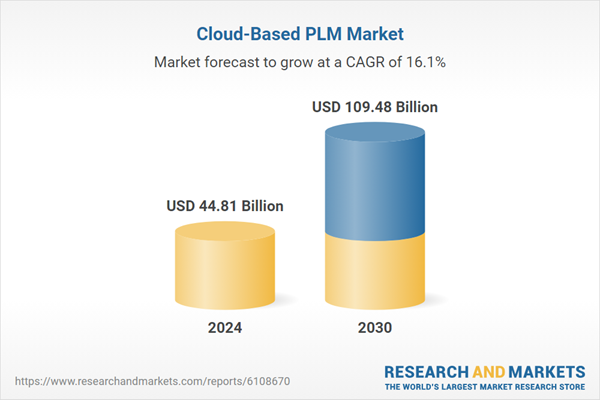Speak directly to the analyst to clarify any post sales queries you may have.
10% Free customizationThis report comes with 10% free customization, enabling you to add data that meets your specific business needs.
Unlike traditional on-premise PLM systems, cloud-based PLM provides cost-effective, scalable, and remotely accessible solutions with rapid deployment capabilities. These platforms promote real-time collaboration across distributed teams, integrating critical functions such as engineering change management, quality assurance, and regulatory compliance into a unified system. As industries accelerate digital transformation and global collaboration becomes the norm, cloud PLM solutions offer businesses the agility and transparency needed to manage increasingly complex products while maintaining innovation and speed-to-market.
Key Market Drivers
Empowering Remote Collaboration for Distributed Product Development Teams
The shift toward globalized operations and hybrid work models has intensified the need for efficient collaboration among design, engineering, and manufacturing teams located across different geographies. Cloud-based PLM platforms serve this need by providing a centralized digital environment that connects all stakeholders - from suppliers to customers - via a shared interface. This eliminates versioning issues, shortens feedback loops, and enhances project visibility. Industries such as automotive, aerospace, and electronics, where regulatory requirements and design complexity are high, increasingly rely on cloud PLM for streamlined operations.These platforms also ensure continuity during disruptions, such as pandemics or geopolitical events, allowing teams to collaborate and make real-time decisions remotely. For example, Siemens reported a 25% reduction in design cycle time after implementing collaborative cloud PLM tools, citing better coordination, reduced delays, and immediate access to updated design files. The model fosters accelerated innovation without compromising control, traceability, or compliance.
Key Market Challenges
Data Security and Compliance Concerns Across Multinational Operations
Despite the growing adoption of cloud-based PLM, concerns about data security and regulatory compliance remain significant - particularly in multinational enterprises operating across jurisdictions with different data protection standards. PLM systems manage critical intellectual property such as design schematics, supplier agreements, testing data, and regulatory documents. Transferring this sensitive information from on-premise infrastructure to cloud platforms raises risks of unauthorized access, cyber threats, and industrial espionage. Moreover, industries like defense, aerospace, and pharmaceuticals must comply with stringent regional regulations such as ITAR in the U.S. or GDPR in Europe. Ensuring that cloud PLM solutions meet these varied requirements without compromising accessibility and performance is a complex challenge for organizations operating on a global scale.Key Market Trends
Integration of Artificial Intelligence in the Cloud-Based PLM Market
The incorporation of artificial intelligence (AI) into cloud-based PLM platforms is transforming how organizations manage product development. AI-driven features such as predictive analytics, anomaly detection, and intelligent design recommendations help identify process inefficiencies, forecast equipment issues, and optimize product configurations. These insights allow companies to reduce development time and costs while improving accuracy and decision-making. Industries facing rising complexity and compliance demands - such as aerospace, automotive, and electronics - are benefiting from AI tools that detect flaws early, simulate production environments, and refine materials planning within a cloud-based ecosystem. As more PLM vendors embed AI and machine learning into their platforms, these systems are evolving into intelligent, adaptive environments that support continuous innovation, real-time insights, and operational automation - making them essential to modern product lifecycle strategies.Key Market Players
- Oracle Corporation
- Tata Consultancy Services Limited
- IBM Corporation
- SAP SE
- Infor
- Ansys, Inc.
- PTC Inc.
- Autodesk, Inc.
Report Scope:
In this report, the Global Cloud-Based PLM Market has been segmented into the following categories, in addition to the industry trends which have also been detailed below:Cloud-Based PLM Market, By Component:
- Software
- Services
Cloud-Based PLM Market, By Technology:
- Radio-Frequency Identification
- Near Field Communication
- Others
Cloud-Based PLM Market, By Application:
- Portfolio Management
- Product Data Management
- Collaborative Design and Engineering
- Customer Management
- Compliance Management
- Others
Cloud-Based PLM Market, By Region:
- North America
- United States
- Canada
- Mexico
- Europe
- Germany
- France
- United Kingdom
- Italy
- Spain
- Asia Pacific
- China
- India
- Japan
- South Korea
- Australia
- Middle East & Africa
- Saudi Arabia
- UAE
- South Africa
- South America
- Brazil
- Colombia
- Argentina
Competitive Landscape
Company Profiles: Detailed analysis of the major companies present in the Global Cloud-Based PLM Market.Available Customizations:
With the given market data, the publisher offers customizations according to a company's specific needs. The following customization options are available for the report.Company Information
- Detailed analysis and profiling of additional market players (up to five).
This product will be delivered within 1-3 business days.
Table of Contents
Companies Mentioned
- Oracle Corporation
- Tata Consultancy Services Limited
- IBM Corporation
- SAP SE
- Infor
- Ansys, Inc.
- PTC Inc.
- Autodesk, Inc.
Table Information
| Report Attribute | Details |
|---|---|
| No. of Pages | 185 |
| Published | July 2025 |
| Forecast Period | 2024 - 2030 |
| Estimated Market Value ( USD | $ 44.81 Billion |
| Forecasted Market Value ( USD | $ 109.48 Billion |
| Compound Annual Growth Rate | 16.0% |
| Regions Covered | Global |
| No. of Companies Mentioned | 8 |









